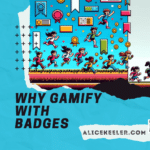Guest Post by Melody McAllister
Where Do I Even Begin?
If you are reading this post because you want to grow in becoming an anti-racist educator, I just want to welcome you. When we want to grow in educational technology tools, there is a never ending source of YouTube videos and blog posts available. We share them out when we find someone’s work especially helpful. We even share with others around us who teach and work with us. That’s kind of how this journey looks, too.
Except…this journey is so much more important.
Unlike learning the latest trends in edtech, this journey requires you to begin inside your own mind. You may find something that resonates on EduTwitter, but if you don’t look inward, first, this journey can’t begin. But you’re here. You’re searching. This isn’t going to be easy, but you can do hard things. Your children and students are worth the work. Your neighbor is worth the work. Humanity is worth the work.
So let’s begin!
Step 1: Personal Reflection
My friend, Hedreich Nichols, has a program on her YouTube called #SmallBites. Her most recent post is about self-reflection. Is it hard to believe that in 2021 there are people and people groups who are still marginalized or not protected equally under the law? Hedreich invites you to listen in and then begin to think deeply and honestly about how you view what you know to be true in your life and what you think is true for others, and when I say others, I mean, Black People, Brown People, or anyone non-white who have been historically marginalized from society.
Step 2: Listen To Others
This isn’t really a journey of neat, defined steps. Learning to be anti-racist looks different for all of us. Some people like to read books. Some like to watch Netflix Documentaries. Others like to talk it through. Some have to do all the above. I’m just listing steps so this doesn’t feel like something you can’t do because it’s too overwhelming.
Here is an important tip if you are a talker: LISTEN.
Stop talking.
Be silent.
Give up judgements.
I’m a talker so this is something that I have to gently remind myself at times, but it’s also become more natural over time, too. So just listen. Maybe you only have white friends. Maybe they all believe the same as you, and no one in any groups you live in have questioned your beliefs. Challenge yourself by listening to others on the news, in books/articles, or any social media broadcast and don’t say anything in return. When you start to feel defensive, don’t shut off the TV or quit reading the book (take a break but come back). When you feel like getting on your high horse, don’t. Write down in a journal and get your thoughts out, but don’t quit listening. Let the discomfort sit on you.
Get used to it. Discomfort will keep you growing.
I promise you that I’m not saying these things out of spite, but it’s time to listen. You might even think about times when you responded to a Student or Colleague of Color, who tried to explain something to you that made absolutely no sense, to which you answered, “That didn’t happen” or something similar in meaning and shut down the conversation. It’s unfortunate, but we as white people do this so much and we are silencing others. We are sending messages to them that are filled with disbelief and they begin to see that we are not trustworthy.
I have done this. I am guilty of this. I am not asking you to do anything that I have not done myself. I am not throwing stones at you laced with judgement. This step takes time. Don’t rush it. Sit in it, lean in, and listen. Lather, rinse, repeat.
Step 3: Google It
Google can help you go in the direction that is more meaningful for you as you grow in becoming anti-racist. In fact, Google the term “anti-racist.” Are there other words or people you have never heard of? Google them too! Google terms such as: systemic racism, redlining, spiritual bypassing, white privilege, and courageous conversations.
Google is your friend when you are on this journey. It can even keep you from hurting someone in the process. What do I mean? Sometimes our white people questions are off-putting and hurtful to People of Color. The ideas we are just now learning, or more aware of about racism, have been reality for our non-white neighbors for their entire lives. In fact, understanding that idea is key in understanding our privilege.
Step 4: Don’t Stop.
The truth is, I could write twenty steps for you to follow in order for you to become anti-racist. But these are the beginning steps. If you take it upon yourself to learn more about racism, and your role in it, you are doing “the work.” This work can help grow you when you commit to it. You will make mistakes along the way. You will need to apologize. Accept that and keep going.
I share about my journey here. I hope I can help you grow as well.
About The Author
Melody McAllister is a wife, mother of five, educator, and author. She and her family relocated to Alaska from the Dallas area in 2019. McAllister is 2017 Garland NAACP Educator of the Year and author of the I’m Sorry Story, a children’s book about taking responsibility for mistakes and making sincere apologies. She is also the Logistics Manager for EduMatch Publishing. McAllister has spoken at ISTE and ASTE about equity issues in education, and writes about her journey in her blog, HeGaveMeAMelody.com.








1 thought on “What’s Next? First Steps in Becoming an Anti-Racist Educator by @mjmcalliwrites”
Good place to start the work of being anti-racist & this is work that does not end. There is always more to learn & as we learn better – we do better.